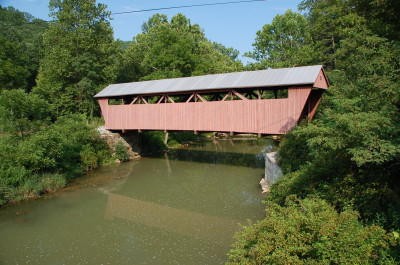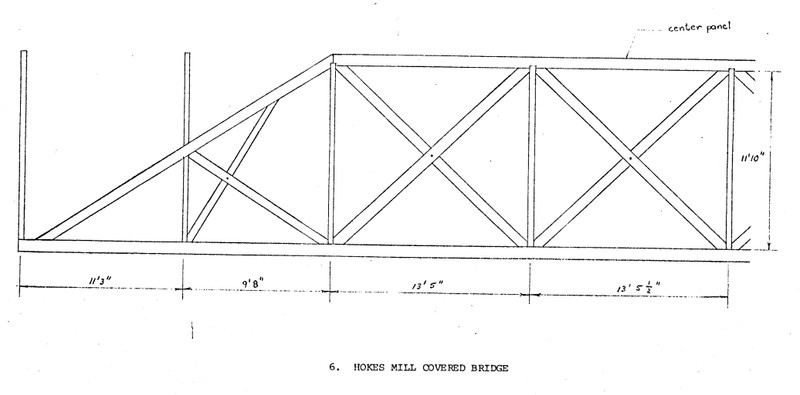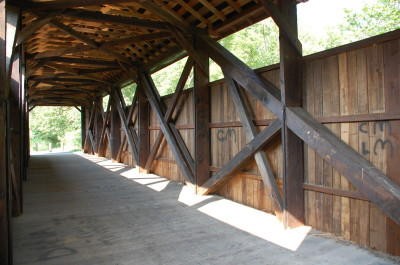Hokes Mill Covered Bridge
Introduction
Text-to-speech Audio
Images
Hokes Mill Covered Bridge

Architectural drawing of the bridge's Long trusses

Interior of the bridge. Note the Long trusses on the sides

Backstory and Context
Text-to-speech Audio
The Hokes Mill Covered Bridge was built at some point between 1897 and 1899, though exact dates are difficult to pin down. In April of 1897, the Greenbrier County Court appointed B. F. Mann, R. A. McDowell, and Austin B. Erwin as commissioners for a new covered bridge crossing Second Creek. The bridge exists on record beginning in the summer of 1899, placing the construction before this date at the very least. The bridge was intended to provide local access to the nearby Hokes Mill. The amount allocated for the construction of the bridge was $700 – a little over $20,000 in today’s money.
At over eighty-one feet long, the Hokes Mill Covered Bridge is a respectable length for a covered bridge. It measures twelve feet wide. The red board-and-batten siding is capped by a standing seam metal roof. The bridge is supported by a series of Long trusses. This truss style was patented in 1830 Stephen H. Long. The defining feature of this style is that the trusses are constructed entirely from wood, with no metal components. The trusses consist of a series of vertical posts spanned by diagonal cross-beams .
Several modifications were made to the Hokes Mill Covered Bridge in the mid-twentieth century. Steel girders and flange beams were placed under the floor to help support the weight of traffic. The bridge was used for vehicular traffic until 1991, when a nearby concrete bridge was constructed to bypass the Hokes Mill Covered Bridge. The Hokes Mill Covered Bridge was subsequently converted to allow pedestrian traffic only. In 2001, Allegheny Restoration and Bldrs, Inc. completed work on the bridge for $391,646. This restoration appears to have removed some of the mid-twentieth century modifications which detracted from the aesthetic and authenticity of the bridge. The Hokes Mill Covered Bridge is significant as one of only five Long truss covered bridges in West Virginia and one of the last two covered bridges in Greenbrier County – the other bridge being Herns Mill Covered Bridge.
Cite This Entry
MacKay, Iain and Kathleen Thompson. "Hokes Mill Covered Bridge." Clio: Your Guide to History. September 21, 2020. Accessed January 10, 2025. https://theclio.com/tour/795/4
Sources
Hanson, Todd A. Covered Bridges, The West Virginia Encyclopedia. May 28th 2019. Accessed August 15th 2020. https://www.wvencyclopedia.org/articles/1660.
Hokes Mill Covered Bridge, West Virginia Department of Transportation. Accessed August 15th 2020. https://transportation.wv.gov/highways/bridge_facts/covered-bridges/Pages/HokesMillCoveredBridge.aspx.
Kemp, E L. Hokes Mill Covered Bridge, National Register of Historic Places. June 4th 1981. Accessed August 15th 2020. http://www.wvculture.org/shpo/nr/pdf/greenbrier/81000599.pdf.
Schmidt, Jack, Brian McKee, and J.P. Hokes Mill Covered Bridge, Bridge Hunter. November 14th 2019. Accessed August 15th 2020. https://bridgehunter.com/wv/greenbrier/hokes-mill-covered/.
Brian McKee
E. L. Kemp
Brian McKee


